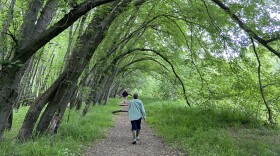This episode was first heard in March 2018 and was produced by Andrew Parrella.
It’s an unmistakable sound; one that elicits memories, sights and scents of events long ago. It recalls the joy of youth, the possibility of a spring evening. But it can also incite insomnia and the blind rage that accompanies it.
Pseudacris crucifer is better known as the spring peeper, and for most people it is a welcome harbinger of the return of spring. These remarkable frogs spend the winter under leaf litter in a state of suspended animation.
Once temperatures are regularly in the forties overnight, peepers start thawing out and begin singing. The ringing chorus is a signal that we’re finally shedding winter’s icy grip. We dare to hope that we’ve seen our last nor’easter of the season, and that warmer and greener days are close at hand.
That hope manifests around the state as it gradually thaws from south to north, and is shared vicariously through social media. Posts pop up first in places like Keene and Pelham; within a day or two Hancock and Hillsboro join in; the following week Franconia and Milan add their voice to the chorus. Before long, as streams begin flowing again and water returns to wetlands, the hills of New Hampshire sing with peepers.
We hear them clearly because they are very loud despite their small size. One study found that when you are within 50 centimeters of a single male peeper, it’s as loud as a motorcycle is from 25-feet away – about 90 decibels. Impressive when you consider your average male peeper is only about an inch and a half long.
From a distance, the chorus of peepers is a little quieter, only about 65 decibels; still about as loud as your average bar room conversation. So when the incessant noise causes your insomniac neighbor to start screaming out the window at these amphibians, cut them some slack.

Peepers tend to intuitively find places that amplify their call; in cracks or crevices, on tall vegetation, or near reflective surfaces like sheets of water. And the amplification can create a ventriloquy effect, casting the chirp all over your backyard and making it difficult to figure out where the frog actually is!
Another reason the peepers seem so loud is psychosomatic. Since the onset of winter, the outdoors has been nearly silent, and we’ve gotten used to that. So, by comparison those peepers are piercing. It’s like having earplugs in for five months then taking them out just as your alarm clock goes off.
So what are they doing? Precisely what you think they are. The peeper’s chirp is a mating call, males advertising for females.
All that sound and fury wraps up pretty quickly as eggs are laid, fertilized and wrapped around plant stems. Mating season is over in just a few weeks.
Peepers then make their way back into the forest for the rest of the spring and summer, in search of the cooler temperatures and damp places that they prefer.
Something Wild is a partnership of the Forest Society, NH Audubon, and NHPR.










